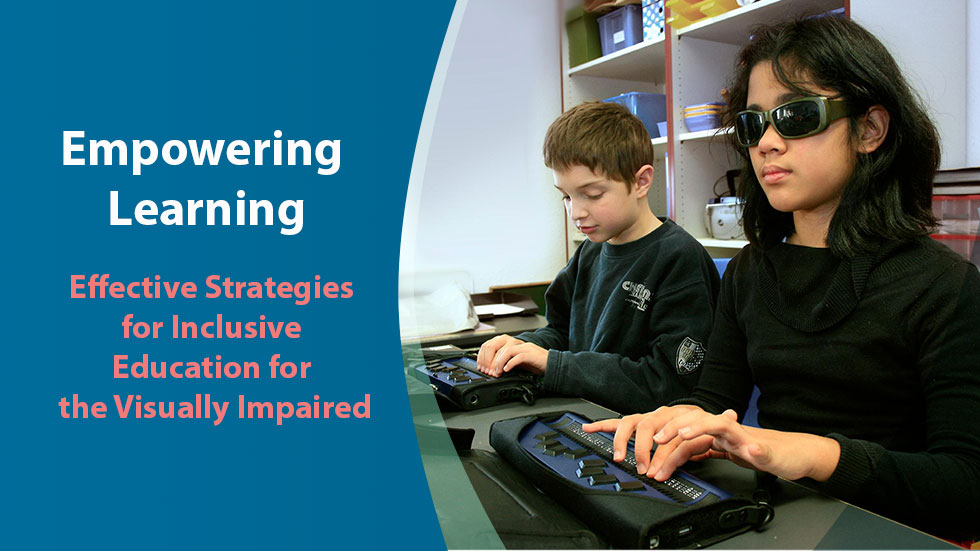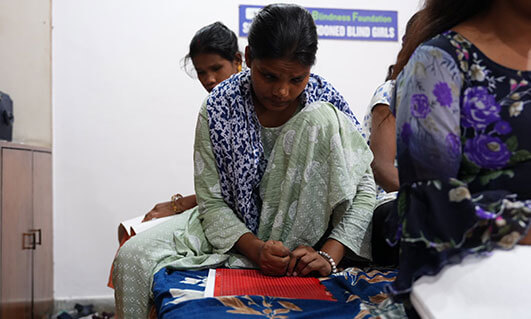
Education is the cornerstone of independence, personal growth, and professional development. For visually impaired students, access to quality education is essential for fostering their potential and preparing them for future success. Inclusive education—where students of all abilities learn together in the same environment—ensures that visually impaired students can thrive academically and socially. This blog explores key strategies for creating an inclusive educational environment that supports the needs of visually impaired students.
The Importance of Inclusive Education
Inclusive education is based on the principle that every student, regardless of their abilities, should have equal access to learning opportunities. For visually impaired students, an inclusive approach:
- Promotes a sense of belonging and self-worth.
- Enhances academic and social skills through interaction with peers.
- Prepares them for a more inclusive society by fostering empathy and understanding among sighted students.
Implementing inclusive education requires schools, teachers, and communities to adopt specific strategies that cater to the needs of visually impaired students, ensuring they can fully participate in the learning process.
Strategies for Success in Inclusive Education
-
Accessible Learning Materials
- Braille Textbooks: Braille is a vital tool for students who are completely blind. Providing textbooks and other learning materials in Braille allows these students to access the same information as their sighted peers.
- Large-Print Materials: For students with low vision, large-print textbooks, worksheets, and exams are necessary. Using bold fonts, high-contrast colors, and clear formatting enhances readability.
- Digital Accessibility: E-books, digital textbooks, and online resources should be compatible with screen readers like JAWS or NVDA. Providing accessible PDFs and using text-to-speech software also allows students to interact with digital content independently.
-
Assistive Technologies
- Screen Readers and Magnification Tools: These tools allow visually impaired students to use computers, tablets, and smartphones for research, writing, and communication. Screen readers convert text into speech, while magnification tools enlarge text and images for students with low vision.
- Braille Displays and Notetakers: These devices translate digital text into Braille, enabling students to read and write in Braille while engaging with classroom content.
- Talking Calculators and Tactile Graphing Tools: These tools help visually impaired students participate in math and science classes. They provide auditory feedback and tactile representation of graphs and equations, making complex subjects more accessible.
-
Adapted Teaching Methods
- Multi-Sensory Teaching: Incorporating multiple senses into the learning experience helps visually impaired students grasp concepts. For example, using tactile maps, 3D models, and audio descriptions in lessons allows students to explore subjects beyond traditional sight-based methods.
- Verbal Explanations and Descriptions: Teachers should provide detailed verbal explanations during demonstrations, on whiteboards, or when using visual aids. This ensures that visually impaired students can follow along with lessons.
- Peer Support and Group Activities: Encouraging collaboration between visually impaired and sighted students promotes inclusion. Assigning peers to support visually impaired students during activities ensures they are fully integrated into group learning experiences.
-
Teacher Training and Support
- Professional Development: Teachers play a critical role in inclusive education. Providing them with training on how to adapt their teaching methods, use assistive technologies, and create an accessible classroom environment is essential. Educators should be knowledgeable about visual impairments, empathetic to the needs of visually impaired students, and skilled in offering necessary support.
- Collaboration with Special Educators: Special education teachers and support staff can work alongside regular classroom teachers to implement individualized education plans (IEPs) for visually impaired students. Regular communication between general and special educators ensures that the curriculum is tailored to the specific needs of each student.
-
Physical Classroom Accommodations
- Seating Arrangements: Visually impaired students should be seated in positions that allow them easy access to the teacher’s voice, instructional materials, and any assistive technologies they use.
- Tactile Markings: Adding tactile markings to classroom items, such as labeling desks, chairs, and doors in Braille or raised letters, helps visually impaired students navigate the space independently.
- Accessible Classroom Layout: A clutter-free and well-organized classroom layout reduces obstacles and makes it easier for visually impaired students to move around safely.
-
Social and Emotional Support
- Building Peer Relationships: Inclusive education promotes social interaction between visually impaired and sighted students. Teachers can facilitate peer partnerships or buddy systems that encourage collaboration, communication, and friendship between students.
- Fostering Independence: Teachers should encourage visually impaired students to advocate for themselves, express their needs, and take on leadership roles in the classroom. This builds confidence and independence, essential for their personal growth.
- Counseling and Emotional Support: Students with visual impairments may face challenges related to self-esteem, social interaction, and anxiety about their future. Providing access to school counselors or support groups can help them navigate these challenges.
-
Collaboration with Parents and Families
- Communication with Families: Maintaining an open line of communication between teachers and the families of visually impaired students ensures that educational strategies are aligned with the student’s needs both at school and at home.
- Involvement in IEP Development: Parents play an important role in shaping the individualized education plan (IEP) for their child. Schools should actively involve parents in discussions about accommodations, goals, and progress to ensure that the student receives comprehensive support.
-
Extracurricular Activities and Inclusion
- Inclusive Sports and Arts Programs: Schools should offer adapted sports programs and arts activities that allow visually impaired students to participate. Sports like goalball or swimming can be inclusive, while tactile art and music classes foster creativity and engagement.
- Access to Field Trips: Ensuring that field trips and extracurricular activities are accessible through the use of assistive devices, tactile learning experiences, and audio guides allows visually impaired students to fully participate in these enriching opportunities.
Conclusion
Inclusive education is not just about ensuring that visually impaired students have access to learning—it’s about creating an environment where all students can thrive. By providing accessible learning materials, assistive technologies, adapted teaching methods, and emotional support, schools can empower visually impaired students to reach their full potential. Collaboration among teachers, special educators, families, and peers is essential for fostering success in the classroom and beyond.
As schools continue to adopt these inclusive strategies, visually impaired students will be better equipped to overcome barriers, build self-confidence, and achieve academic success. Through inclusive education, we can create a world where every student—regardless of their ability—has the opportunity to learn, grow, and thrive.





